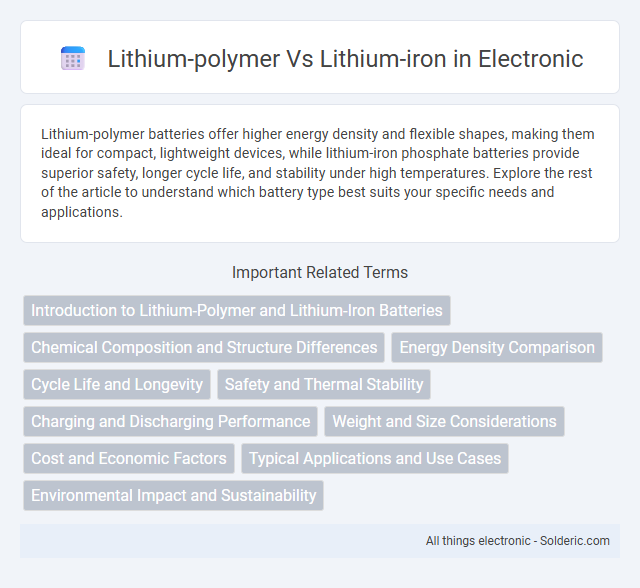Lithium-polymer batteries offer higher energy density and flexible shapes, making them ideal for compact, lightweight devices, while lithium-iron phosphate batteries provide superior safety, longer cycle life, and stability under high temperatures. Explore the rest of the article to understand which battery type best suits your specific needs and applications.
Comparison Table
| Feature | Lithium-Polymer (Li-Po) | Lithium-Iron Phosphate (LiFePO4) |
|---|---|---|
| Energy Density | High (150-200 Wh/kg) | Moderate (90-120 Wh/kg) |
| Cycle Life | 300-500 cycles | 2000-3000 cycles |
| Safety | Moderate, risk of swelling/fire | High, stable thermal and chemical properties |
| Weight | Lightweight | Heavier |
| Cost | Higher | Lower |
| Voltage | 3.7 V nominal | 3.2 V nominal |
| Applications | Consumer electronics, drones, RC models | Electric vehicles, solar energy storage, power tools |
Introduction to Lithium-Polymer and Lithium-Iron Batteries
Lithium-polymer batteries use a polymer electrolyte, offering a lightweight, flexible design ideal for portable electronics and drones, whereas lithium-iron phosphate batteries, known for their superior thermal stability and long cycle life, are commonly used in electric vehicles and energy storage systems. Both battery types provide high energy density, but lithium-iron phosphate excels in safety and durability under extreme conditions. Your choice depends on balancing weight, safety, and longevity requirements for the specific application.
Chemical Composition and Structure Differences
Lithium-polymer batteries use a gel-like polymer electrolyte that enables flexible shapes and lightweight designs, while lithium-iron phosphate (LiFePO4) batteries incorporate a crystalline anode structure with iron phosphate, providing enhanced thermal stability and safety. The chemical composition of lithium-polymer cells typically involves lithium cobalt oxide cathodes, contrasted with lithium-iron phosphate cathodes in LiFePO4 cells, resulting in differences in energy density and voltage output. Structural differences affect ion flow and battery lifespan, with lithium-iron phosphate offering a more robust crystal lattice that supports longer cycle life and improved resistance to overheating.
Energy Density Comparison
Lithium-polymer batteries typically offer higher energy density, ranging from 150 to 250 Wh/kg, enabling longer usage times in compact devices. Lithium-iron phosphate (LiFePO4) batteries have a lower energy density, around 90 to 120 Wh/kg, but provide greater thermal stability and longer cycle life. The trade-off between energy density and safety makes lithium-polymer suitable for lightweight electronics, while lithium-iron excels in applications requiring durability and reliability.
Cycle Life and Longevity
Lithium-polymer batteries typically offer a cycle life ranging from 300 to 500 charge-discharge cycles, with relatively moderate longevity due to their flexible electrolyte design. In contrast, lithium-iron phosphate (LiFePO4) batteries exhibit a significantly longer cycle life, often exceeding 2,000 to 3,000 cycles, resulting from their stable cathode chemistry and enhanced thermal stability. The extended cycle life and durability of lithium-iron batteries make them ideal for applications requiring long-term reliability and consistent performance.
Safety and Thermal Stability
Lithium-polymer batteries offer flexible design and lightweight benefits but are more prone to swelling and thermal runaway under extreme conditions. Lithium-iron phosphate batteries provide superior safety and thermal stability, maintaining performance at higher temperatures with a reduced risk of overheating or fire. Choosing lithium-iron ensures enhanced protection for your devices in demanding environments without compromising battery lifespan.
Charging and Discharging Performance
Lithium-polymer batteries exhibit higher charging and discharging rates due to their flexible electrolyte design, allowing faster energy transfer and improved power density. Lithium-iron phosphate (LiFePO4) batteries provide more stable discharge performance with a flatter voltage curve, enhancing consistency during use and better thermal management for longer cycle life. Faster charge acceptance in lithium-polymer batteries supports quick recharge cycles, whereas lithium-iron phosphate cells are favored for applications requiring prolonged durability and safety under high discharge currents.
Weight and Size Considerations
Lithium-polymer batteries are generally lighter and more compact than lithium-iron phosphate batteries, making them ideal for portable electronic devices and applications where weight and space are critical. Lithium-iron phosphate batteries tend to have a larger size and higher weight due to their robust chemical structure, which provides enhanced safety and longer cycle life but at the expense of portability. Choosing between the two depends on balancing the need for lightweight design against durability and battery lifespan requirements.
Cost and Economic Factors
Lithium-polymer batteries generally cost more due to their flexible design and lightweight properties, making them ideal for portable electronics where size and weight are crucial. Lithium-iron phosphate batteries offer a lower upfront cost and longer lifespan, translating to better long-term economic value for applications like electric vehicles and energy storage systems. Your choice depends on balancing initial investment with durability and application-specific requirements.
Typical Applications and Use Cases
Lithium-polymer batteries are commonly used in portable electronics like smartphones, tablets, and remote-controlled drones due to their flexible shape and lightweight design, enabling compact and customized device forms. Lithium-iron phosphate (LiFePO4) batteries are favored in electric vehicles, solar energy storage systems, and power tools for their superior safety, longer cycle life, and thermal stability. The choice between lithium-polymer and lithium-iron phosphate batteries depends on application-specific requirements such as energy density, durability, and safety priorities.
Environmental Impact and Sustainability
Lithium-polymer batteries, known for their lightweight design, often require more complex manufacturing processes that can increase carbon emissions compared to lithium-iron phosphate (LiFePO4) batteries, which utilize abundant, non-toxic materials with better recyclability. Lithium-iron batteries exhibit greater thermal stability and longer cycle life, reducing waste and environmental impact through extended usability and decreased frequency of replacement. Your choice between these battery types can significantly influence eco-friendliness and sustainability, with lithium-iron phosphate emerging as the more environmentally responsible option.
Lithium-polymer vs Lithium-iron Infographic

 solderic.com
solderic.com